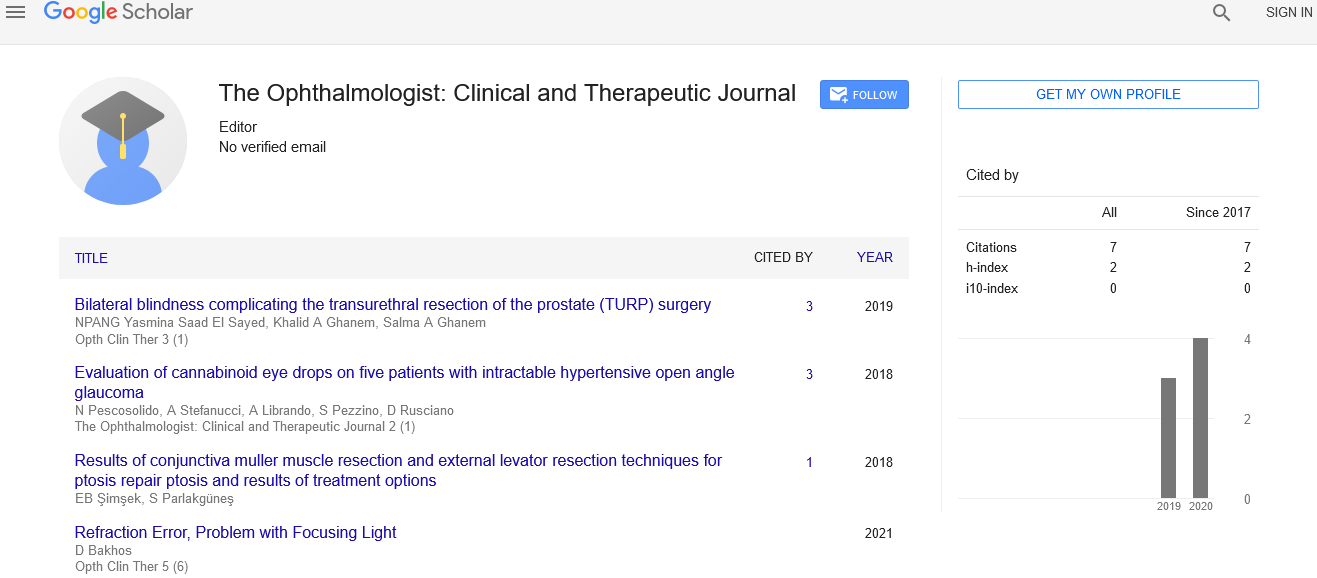The moment for visual electrophysiology has come
Received: 16-Oct-2023, Manuscript No. PULOCTJ-23-6803; Editor assigned: 18-Oct-2023, Pre QC No. PULOCTJ-23-6803 (PQ); Reviewed: 02-Nov-2023 QC No. PULOCTJ-23-6803; Revised: 05-Sep-2024, Manuscript No. PULOCTJ-23-6803 (R); Published: 12-Sep-2024
Citation: Josh A. The moment for visual electrophysiology has come. Opth Clin Ther. 2024;8(1):1-2.
This open-access article is distributed under the terms of the Creative Commons Attribution Non-Commercial License (CC BY-NC) (http://creativecommons.org/licenses/by-nc/4.0/), which permits reuse, distribution and reproduction of the article, provided that the original work is properly cited and the reuse is restricted to noncommercial purposes. For commercial reuse, contact reprints@pulsus.com
Abstract
Visual electrophysiology, a field encompassing the study of the electrical activities of the visual system, has witnessed significant advancements and innovations in recent years. This article explores the evolution and importance of visual electrophysiology in understanding the intricacies of visual perception and its clinical applications. The integration of cuttingedge technologies and methodologies has elevated the relevance of visual electrophysiology, making it a pivotal tool in both research and clinical practice. This article emphasizes the growing significance of visual electrophysiology in unraveling the mysteries of the visual system and its promising potential for revolutionizing ophthalmic diagnostics and treatments.
Keywords
Visual electrophysiology; Electrical activities; Visual system; Diagnostics; Clinical applications
Introduction
Visual electrophysiology focuses on the study of electrical activities in the visual system, encompassing the retina, optic nerve, and visual cortex. These electrical signals are fundamental to the processes of visual perception and are essential for understanding the functionality and health of the visual pathway. The development of advanced electrophysiological techniques has opened up new possibilities for investigating various aspects of vision, ranging from basic research to clinical applications.
Electrophysiological recordings, such as Electroretinography (ERG) and Visual Evoked Potentials (VEP), provide valuable insights into the function and health of the visual system. ERG measures the electrical response of the retina to light stimuli, aiding in the diagnosis of retinal diseases and assessing overall retinal health. VEP, on the other hand, records the electrical activity generated in the visual cortex in response to visual stimuli, aiding in the evaluation of optic nerve function and identifying pathologies affecting the central visual pathway.
In recent years, the integration of advanced technologies, such as highdensity Electroencephalography (EEG) and functional Magnetic Resonance Imaging (fMRI), has enhanced the capabilities of visual electrophysiology. These technologies allow for more precise and detailed mapping of electrical activities in the brain, enabling a deeper understanding of visual processing and its intricacies.
Electrophysiological studies have revealed critical insights into the mechanisms of various vision-related disorders, including glaucoma, macular degeneration, and optic neuritis. By studying the electrophysiological responses of patients with these conditions, clinicians can tailor treatments and monitor disease progression effectively.
Description
Moreover, the growing field of optogenetics a technique that uses light to control genetically modified neurons has potential applications in visual electrophysiology. Researchers are exploring how optogenetic tools can be used to restore vision in degenerative diseases by selectively activating photoreceptors or other retinal cells. This innovative approach could lead to novel treatment strategies that directly target the underlying mechanisms of vision loss.
The role of Artificial Intelligence (AI) and machine learning in visual electrophysiology is also emerging as a promising frontier. By analyzing vast datasets generated from electrophysiological recordings, AI algorithms can identify patterns and predict outcomes, enhancing diagnostic accuracy and personalizing treatment plans. This integration of technology could lead to more effective management of vision disorders, ultimately improving patient care.
Additionally, visual electrophysiology is proving invaluable in the context of clinical trials for new therapies. By monitoring the electrophysiological responses of participants, researchers can assess the efficacy of novel treatments in real-time, providing immediate feedback on their effects. This can expedite the development of new interventions and improve patient outcomes by ensuring that only the most effective treatments advance through the clinical pipeline.
Another area of interest is the potential for visual electrophysiology to contribute to our understanding of neuroplasticity in the visual system. Research has shown that the brain's ability to adapt and reorganize itself can be influenced by visual experiences. Electrophysiological techniques can be employed to study how different therapies, such as vision rehabilitation or training programs, affect the electrical activity in the visual cortex, offering insights into how best to facilitate recovery and enhance visual function.
In conclusion, advancements in visual electrophysiology have positioned it as a crucial tool for studying the electrical activities of the visual system. The integration of cutting-edge technologies has enhanced our understanding of visual perception and its underlying mechanisms, making it an invaluable asset in both research and clinical settings. Furthermore, visual electrophysiology holds immense potential for improving ophthalmic diagnostics and treatments, offering personalized approaches for patients with vision-related disorders. As technology continues to evolve, visual electrophysiology will play an increasingly prominent role in enhancing our understanding of vision and improving the quality of eye care, paving the way for innovative therapeutic strategies that can transform the lives of those affected by visual impairments. With ongoing research and collaboration across disciplines, the future of visual electrophysiology looks promising, with the potential to uncover new pathways to vision restoration and enhanced patient outcomes.
Conclusion
The advancements in visual electrophysiology have positioned it as a crucial tool in the study of the visual system's electrical activities. The integration of cutting-edge technologies has enhanced our understanding of visual perception and its underlying mechanisms. Moreover, visual electrophysiology holds immense potential for improving ophthalmic diagnostics and treatments, offering personalized approaches for patients with vision-related disorders.
As technology continues to evolve, visual electrophysiology will play an increasingly prominent role in both research and clinical practice, revolutionizing our understanding of vision and improving the quality of eye care.





